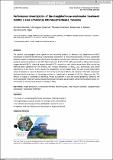| dc.description.abstract | The present study engaged onsite operations and laboratory analysis for Mwanza City Slaughterhouse (MCS)
wastewater to improve the efficiency of wastewater treatment of a newly installed facility. The MCS wastewater
treatment facility is integrated with various units-biodigester, aeration unit, retention, clarifier, and a constructed
wetland. During the initial runs, the MCS facility removed 87.5%, 92.2%, 43%, and 65.4% of effluent biochemical
oxygen demand (BOD5), chemical oxygen demand (COD), ammonium, and nitrate, respectively. After conducting
effective plant operations for five months, the removal efficiencies of BOD5, COD, ammonium, and nitrate
improved to 97.4%, 98.3%, 97.4%, and 97.6%, respectively. In the present study, the unit-by-unit performance
values achieved as a result of alterations to the facility’s running conditions are presented. The MCS wastewater
treatment facility was found to be energy-positive, as it produced an average of 158.2 m3 biogas per day. This
amount of biogas, if converted to electricity, would be sufficient to run the facility operations. Generally, the
MCS wastewater treatment facility attained the best performance as per design, achieving the effluent levels recommended by the Tanzania Bureau of Standards (TBS). | en_US |

